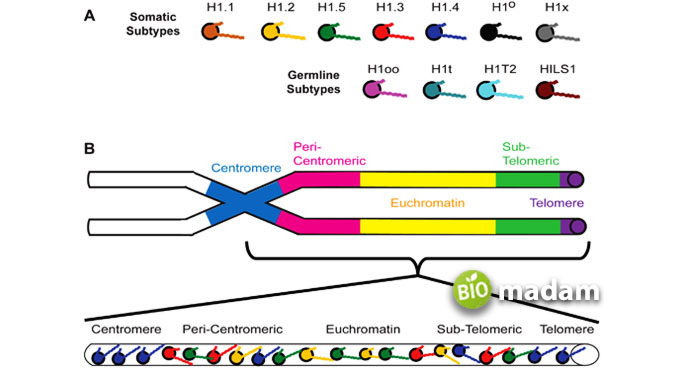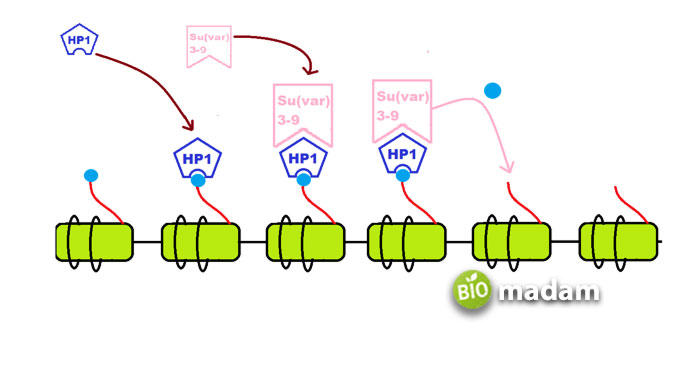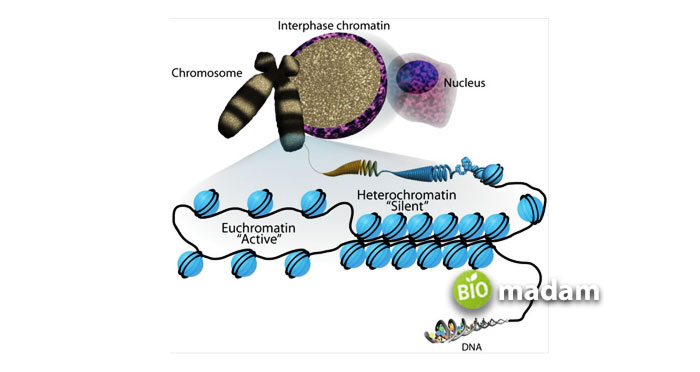Recently updated on September 5th, 2023 at 12:44 pm
Before differentiating between euchromatin and heterochromatin, one must understand what chromatin is. During the interphase, it is an essential component inside the cell nucleus made of DNA and histone proteins. Chromatin packs the DNA into small volumes to adjust in the cell, strengthening it for mitosis and meiosis. The entire chromatin structure is either euchromatin or heterochromatin, helping in replication gene expression and saving DNA from damage.
Although both are chromatin types, their dissimilarities make them significant. Now, if you wonder what do heterochromatin and euchromatin do, we have a complete article written on it below! However, euchromatin is the active chromatin inside the nucleus, whereas heterochromatin is the inactive form of chromatin. Let’s discuss the differences between euchromatin and heterochromatin in detail.
Comparison Table
| Factor | Euchromatin | Heterochromatin |
| Presence | Eukaryotes and prokaryotes | Eukaryotes |
| Location | Centre of the cell | Cell’s periphery |
| Structure | Beaded structure | Compact structure |
| Function | Transcription, and gene variation | Genome structure, and gene regulation |
| Genetic Process influence | Yes | No |
| Genome content | 90% in humans | 8-10% in humans |
| Stickiness | No such regions | Sticky |
| Staining | Lightly stained | Dark stained |
| Examples | Most chromosomes | Genes 1, 9, 16 |
What is Chromatin?
As mentioned earlier, chromatin is the genetic material inside the nucleus, made of DNA and proteins. DNA carries genetic information, while proteins help bind the genetic material into a compact form to fit in the nucleus. Chromatin is the unwound form of chromosomes that packages to create chromosomes at the time of division. A complete chromatin body is divided into euchromatin and heterochromatin.
Let’s continue to know about euchromatin vs heterochromatin.
What is Euchromatin?
According to the name Euchromatin, the “true chromatin” is loosely packed and actively involved in transcription to produce mRNA. The structure of euchromatin and nucleosomes is alike, with 147 DNA base pairs wrapped around the histone proteins. The loosely bound DNA enables quick transcription due to its immediate availability. The gene-regulating mechanism makes it possible to transform heterochromatin into euchromatin and vice versa. Euchromatin is involved in transcription using active genes and helps encode functional proteins. Euchromatin is said to contain 90% of the total human genome

What is Heterochromatin?
Now, the subsequent question coming to your mind must be how is euchromatin different from heterochromatin? Although both replicate at different times, heterochromatin is the highly compact and dense chromatin, preventing RNA and DNA polymerase and other proteins from finding their way to the DNA. Heterochromatin is only present in the nucleus of eukaryotes to help in replication. It is of two types, facultative and constitutive heterochromatin. The facultative heterochromosomes are inactive genes and are not a permanent feature of all cell nuclei. They form through the process of siRNA or histone methylation. Alternatively, constitutive heterochromatin makes the repetitive, functional genes like centromeres and telomeres. They are the continuing nature of the nucleus and retain their structure during the interphase of cell division.

Similarities between Euchromatin and Heterochromatin
Besides the euchromatin and heterochromatin differences, these will remain the types of chromatins; thus, they have some common points. These are explained below:
- Both are the DNA sequences formed of polynucleotide chains but with different functions.
- Besides, both are assembled via primary nucleosome assembly.
- Moreover, these types of chromatins are prominent during the interphase stage of cell division.
- Euchromatin and heterochromatin have special features to interact with a specific type of protein called histone protein. These protein structures help in chromosome packaging.
Euchromatin vs Heterochromatin – Primary Differences
Definition
Euchromatin
Euchromatin is the loosely packed form of DNA containing different segments of genes in the nucleus and transcription.
Heterochromatin
On the other hand, heterochromatin is tightly packed DNA present in the nucleus and is transcriptionally inactive.
Presence
Euchromatin
The loose part of chromatin, i.e., euchromatin, is found in the nucleus of both prokaryotes and eukaryotes.
Heterochromatin
Unlike euchromatin, you can observe heterochromatin only in eukaryotic organisms through a microscope.
Location
Euchromatin
You will observe euchromatin widely distributed in the center or inner body of the nucleus.
Heterochromatin
Whereas, when going through euchromatin vs heterochromatin, the latter is more prominent along the periphery of the cell nucleus.
Structure
Euchromatin
The DNA of euchromatin forms a loose beaded structure within the nucleus to fit well.
Heterochromatin
However, the DNA of a heterochromatin is wrapped around a structural protein called histone protein to form a compact structure.
Function
Euchromatin
Euchromatin is entirely different from heterochromatin when it comes to functions. It enables the process of transcription and gene variation occurring within the genes.
Heterochromatin
In contrast, heterochromatin is responsible for maintaining the structure of the genome and gene expression regulation.
Activity
Euchromatin
Euchromatin is transcriptionally active and involved in transcription that further helps maintain the chromosomal organization and cellular functions.
Heterochromatin
Contrary to euchromatin, heterochromatin is not involved in transcription and is transcriptionally inactive.
Genetic Process Influence
Euchromatin
There is a substantial genetic influence on the chromatin types. For example, euchromatin is affected by numerous genetic processes like position-effect variegation.
Heterochromatin
Discussing the other type of chromatin, i.e., heterochromatin, is not even slightly affected by the genetic processes.
Genome Content
Euchromatin
Euchromatin comprises most of the human genome, comprising around 90% of the total.
Heterochromatin
Whereas heterochromatin makes a smaller part of the genome, making around 8 – 10% of the human genome.
Stickiness
Euchromatin
In the euchromatin vs. heterochromatin race, the former does not have sticky regions in the structure.
Heterochromatin
Alternatively, heterochromatin has some sticky regions to help chromatin make its place inside the nucleus.
Staining
Euchromatin
Euchromatin appears as the lightly stained type of chromatin.
Heterochromatin
When observed under a microscope, heterochromatin appears to be darkly stained.
Examples
Euchromatin
All types of chromosomes in a genome are examples of euchromatin besides heterochromatin.
Heterochromatin
Some of the heterochromatin present in the genome are genes 1, 9, and 16.

The Bottom Line
Heterochromatin and euchromatin are both types of chromatin and essential parts of the cell. When discussing euchromatin vs heterochromatin, both are different and have specific roles. The euchromatin is directly involved in transcription, while heterochromatin maintains the genome structure. There must be numerous differences between the two, but heterochromatin contributes to 10% of the genome in eukaryotes. In short, euchromatin and heterochromatin are crucial in stabilizing gene regulation and balancing the human genome.
FAQs
How does the euchromatin look under a microscope?
You cannot see hetero and euchromatin distinctly under a student microscope. However, one can easily observe it under a compound or electron microscope. Heterochromatin is darkly stained, loosely packed chromatin, while euchromatin is comparatively stained as light pink.
What does the chromatin turn into?
Chromatin folds into specific formations called chromosomes having DNA strands and proteins. They contain the genetic material of the cell and are involved in cell division.
How much chromatin does each chromosome have?
Each chromatin forms one chromosome, which means that every chromosome has one chromatin.
What are the components of chromatin?
Chromatin is primarily made of histone proteins, DNA and RNA. Sometimes, students wonder if it contains lipids; no, lipids are not a component of chromatin.
Is chromatin present in bacteria?
Chromatin is not present in bacteria in the same shape as eukaryotes. However, it forms a membrane-free region commonly known as the nucleoid that modifies shape according to the bacterial state.

Hello, I would like to introduce myself to you! I am Chelsea Rogers, an experienced blog writer for science articles, holding an MPhil degree. My enthusiasm to grab the best knowledge, let it relate to botany, zoology, or any other science branch. Read my articles & let me wait for your words s in the comment section.

